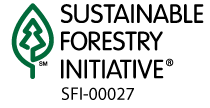xxx,xxx,xxx,xxx
METRIC TONS OF CO2
EQUIVALENT TO
SCRUBBING FROM THE AIR THE ANNUAL
CO2 EMISSIONS FROM xxx.xxx,xxx,xxx VEHICLES
Big Leaf Maple
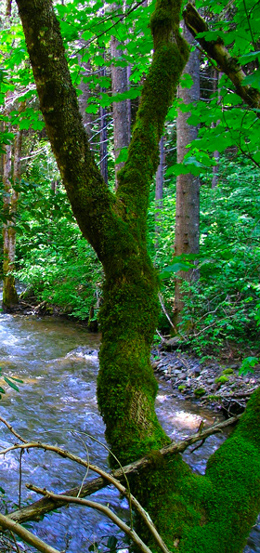
Shady creeks and meadow edges from 1,000 to 5,000 feet in elevation are the places to find Bigleaf Maple. Our foresters report seeing some maple leaves that are nearly 12 inches wide - making them truly bigleafed. This is an important stream zone tree that provides shade, food, and diversity. The maple is not harvested commercially.
More Information
Black Oak
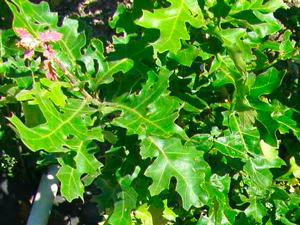
Black Oaks are common just above the foothills in the Ponderosa Pine habitat. As hardwoods, they lose their leaves in the fall, but the next spring a bright green bud burst of Black Oak foliage complements the deep green of the conifers. Black Oak acorns are an important food source for birds and mammals and typically mature in two years. Autumn turns the leaves a golden yellow-brown. On average, Black Oak comprises less than five percent of mixed-conifer stands on Sierra Pacific Industries' forests. The species is occasionally harvested for firewood or hardwood flooring.
More Information
Coast Redwood and Giant Sequoia
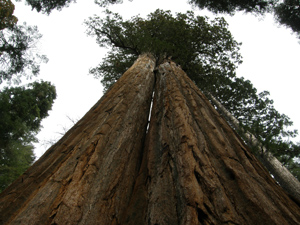 Giant Sequoia
Giant Sequoia
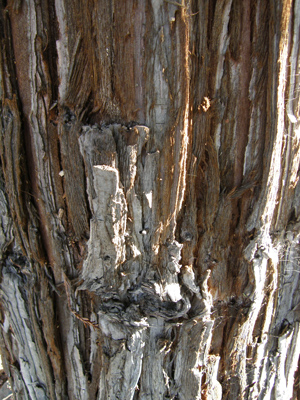 Coast Redwood
Coast Redwood
Forest fire is an important factor in Giant Sequoia regeneration. The small seeds must fall onto bare mineral soil to have a good chance at germinating and surviving. Forest fires often clear the ground of twigs and leaves to provide this seedbed. Coast Redwoods are noted for their sprouting ability, fast growth, and beautiful wood. Both Coast Redwood and Giant Sequoia have tremendous aesthetic and sentimental value, which has contributed to the controversy over the years about logging these species. Sierra Pacific Industries has acquired very little acreage containing Coast Redwood, and on that acreage all of the original trees have been harvested. But fast-growing young stands of planted seedlings and sprouts from the stumps of these large trees are regenerating. SPI in addition to past owners of some of SPI's recently acquired land have planted small groves of Giant Sequoia across its historic range as part of a genetic conservation effort to preserve the species into the future. The majority of old growth and established Giant Sequoia groves are in a few isolated protected parks. In an effort to conserve this species for future generations, an increased number of small groves scattered across its historic range will help contribute to the genetic diversity and potential survival in the future. Although the species has attractive growth qualities and height SPI does not intend to harvest these small groves in the future, but rather leave them on the landscape for conservation and wildlife. We have confidence in the abilities of species naturally occurring on specific sites to grow well, to be adapted to local conditions, and to be resistant to native diseases and pathogens.
More Information about Coast Redwood
More Information about Giant Sequoia
Douglas Fir
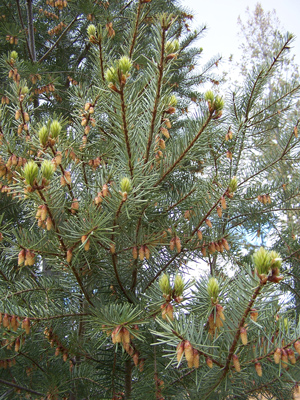
Douglas Fir is a major component of northern California forests but becomes less prevalent as you travel south toward Yosemite. It is found in pure stands on the California coast and in western Oregon and Washington but is usually mixed with other species on Sierra Pacific Industries' lands in the Cascade and northern Sierra Nevada ranges, where elevations range from 2000 to 6000 feet. In the Klamath and Coastal ranges it is the predominant conifer in the forest. Douglas Fir has soft, green needles about one inch long that grow all around the twig, giving the branchlets a bottle-brush appearance. The cones are brown, three to four inches long, and often litter the forest floor beneath the tree. The wood is valued for its strength, light weight, and resistance to decay. It is used extensively for structural lumber, such as two-by-fours and two-by-sixes, and plywood. The seeds are food for squirrels, mice, and birds. Named after the botanist David Douglas, Douglas Fir's scientific name is Pseudotsuga, which means "false hemlock".
More Information
Gray Pine
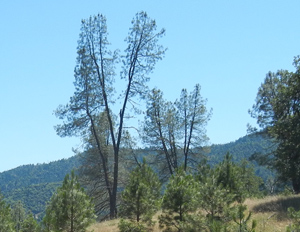
Gray Pine (or Foothill Pine) is found in the hills between 500 and 4,000 feet in elevation, mixed in with various oaks and shrubs. It has long, gray-green needles grouped in bundles of three. The cones are very large and heavy with sharp points on the outside of the cone scales. The cones are so heavy that they can cause serious injury if one falls and hits you. Another distinguishing characteristic of the Gray Pine is forking of the trunk. Generally, the bark is dark gray with irregular furrows, although older trees may form yellow bark plates. The nuts from this pine were an important food source for Native Americans, partly because of their large size. Although it is not harvested extensively, commercial uses of the wood include railroad ties, chips for paper, and pallets.
More Information
Incense-cedar
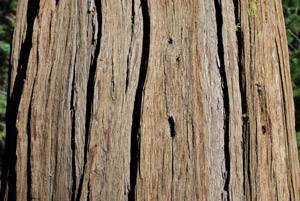
Incense-cedar has reddish-brown fibrous bark and small scale-like leaves growing in flattened branchlets. Incense-cedars attain heights of 100 to 150 feet and diameters of 3 to 4 feet. Rarely found in pure stands, Incense-cedar is a minor component of the mixed-conifer forest, comprising less than 25% of the stand. Because it is more tolerant of shade than Ponderosa Pine, Incense-cedar is often found under the crowns of larger pines. Suppression of fire and logging practices over the last 100 years have led to an increase in the amount of cedar in mixed-conifer forests. Like White Fir, young Incense-cedar trees are killed by fires due to their thin bark and dense foliage. The wood is decay resistant and has very uniform texture, and is easily milled to a fine point. Incense-cedar is used for making pencils. In fact, all cedar used in pencils comes from California and southern Oregon. The wood is also used for fences and paneling. Waste sawdust is combined with wax and formed into fireplace logs.
More Information
Jeffrey Pine
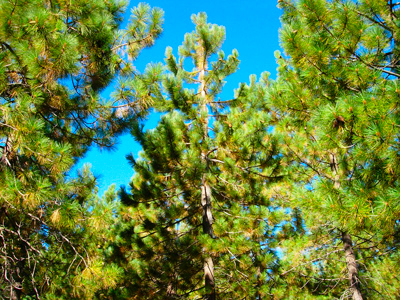
Very much like Ponderosa Pine, Jeffrey Pine also has three needles per bundle. Its cone scales have prickles that curve inward (giving it a nickname of "gentle Jeffrey") as opposed to Ponderosa Pine, whose prickles curve outward ("prickly ponderosa"). Some say if you smell the bark you will notice a vanilla flavor. It is often found just above the Ponderosa Pine in elevation. In some areas, its presence is an indicator of a serpentine-type soil. It is harvested for lumber and marketed along with Ponderosa Pine.
More Information
Lodgepole Pine
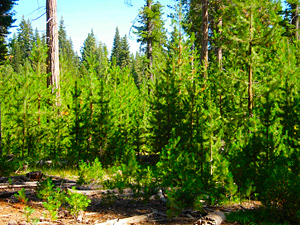
Early settlers building cabins gave this species its common name. The logs from this tree were used in homestead construction. Lodgepole Pines are common across higher elevations from the Rocky Mountains to the Sierra Nevada, but California's lodgepole pines seem to be more variable in shape than in other areas. Lodgepole Pine is a good indicator of a high water table: areas where most other conifers grow poorly. It is an invader of meadows especially in the absence of fire, a process of ecological succession. Regeneration from seed is typically very successful, especially after a fire.
More Information
Mountain Hemlock
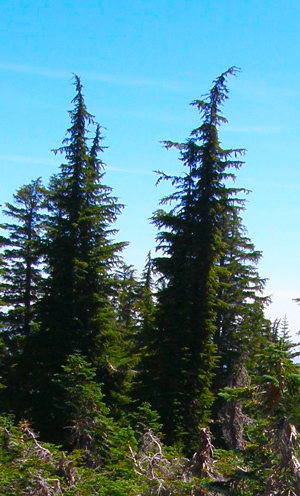
This species grows at the upper-most elevations of Sierra Pacific Industries' ownership: from 6,000 feet to the tree line. It is a graceful tree with a quick taper and a tip that nods over. Small groves of trees may be found on the north or east slopes in sheltered areas. SPI rarely harvests this tree.
More Information
Pacific Yew

This tree is common in the Pacific Northwest. When it does occur on Sierra Pacific Industries' lands, the Pacific Yew is usually found along shady watercourses. It received publicity in the last few years because of a chemical ingredient called taxol found in its bark and needles. This chemical was used to successfully treat ovarian cancer in some women. Bark from trees was stripped and sent to drug processing laboratories for chemical extraction, but three yew trees were needed to distill enough taxol for just one cancer patient. Since then, scientists have been able to isolate the chemical and produce it synthetically, so trees are no longer harvested for this important medical purpose.
Now, there is little commercial use of the species, and SPI does not harvest this tree for lumber. To maintain species diversity, Sierra Pacific recognizes Pacific Yew as a component of healthy stream-side zones.
More InformationPonderosa Pine
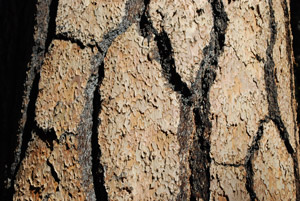
Ponderosa Pine is a dominant tree species in Sierra Pacific Industries' mixed-conifer forests. It is found in nearly pure stands (with some black oak) at 2,000 feet in elevation, and it is a major component of forests in the 3,000 to 5,000 foot elevation range. It is not usually found above 6,500 feet. Looking at the needles, you will see that they are in bundles of three. The seeds mature in prickly cones about five inches long. Look for the cones lying on the forest floor like corncobs, the seeds having been eaten by rodents and birds. Young trees have brown bark with no plates. Old trees have platy, pumpkin-orange bark. Ponderosa Pine is a "pioneer" species in the life cycle of the forest, meaning that its tolerance to drought and to heat make it one of the first conifers to reforest a burn or to come in after a harvest. However, extended drought can weaken the trees so that they are susceptible to bark beetles.
More Information
Red Fir
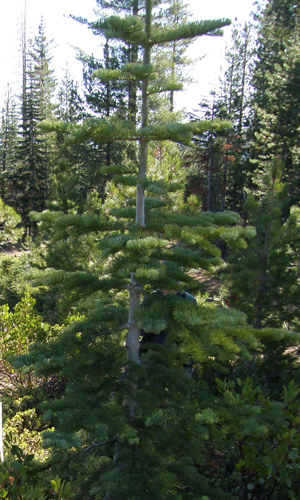
Red Fir is a close relative of the White Fir, and the two species look similar. The major difference is that Red Fir grows at higher elevations so that as one travels from 5,000 to 7,000 feet in elevation, these trees dominate the landscape. Most Californians who purchase Christmas trees know this tree as the "Silver Tip Fir." Each needle on the tree has faint white stripes (actually bands of stomata that take in carbon dioxide from the atmosphere and emit oxygen), giving the tree a silvery appearance. Proper Christmas tree harvesting does not kill the tree. Typically, trees are not cut off at the ground; but rather, live branches are left below the cut. These branches then turn up and act as new stems, yielding, in seven or eight years, new Christmas trees. At high elevations, there is a scarcity of food-producing plants, so Red Firs with their fissured bark, broken tops, and upright cones provide needed food and shelter to birds and small mammals.
More Information
Sugar Pine
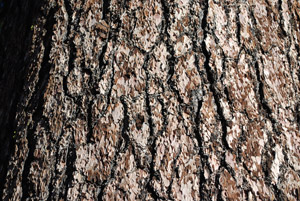
The largest member of the pine family is the Sugar Pine, which can grow as tall as 250 feet and up to 10 feet in diameter. Sugar Pines are found at elevations ranging from 3,000 to 6,000 feet. The Sugar Pine is rarely found in pure stands except in small, scattered areas. Old trees have a characteristic purplish-brown bark of scaly ridges. Also distinguishing is its very large cones, which can range from 16 to 26 inches long. Its needles are shorter than those of Ponderosa Pine and are in bundles of five. Sugar Pine has an impressively fast growth rate. A major lumber species, Sugar Pine is used for moldings, cabinets, and wood-framed windows. Native Americans used the seeds for food and a sugary substance from the resin, called pinitol, for food and eyewash. Sugar Pine is susceptible to bark beetles and to an introduced disease called white pine blister rust. Sierra Pacific Industries cooperates in extensive genetic research work to identify individual trees resistant to the rust's deadly effects.
More Information
Tanoak
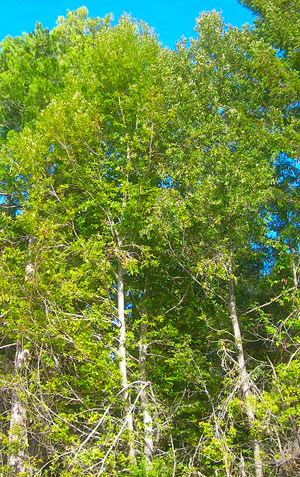
Tanoak is an evergreen shrub species that can be found at elevations ranging from 2,000 to 5,000 feet, but occurs in only a few localized portions of Sierra Pacific Industries' ownership. It often forms dense stands, shading out all other species, and does well in sun or shade. If tanoak is in the understory when overstory trees are removed, it responds rapidly and grows to occupy the space, becoming a small tree. Conifer regeneration in these stands is difficult. Since SPI foresters emphasize management for conifer species, they attempt to keep the percentage of this hardwood species in a stand to less than five percent.
More InformationWestern Hemlock
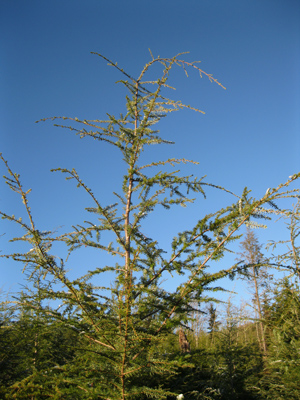
(Tsuga heterophylla), also called Pacific Hemlock and West Coast Hemlock, thrives in humid areas of the Pacific coast and northern Rocky Mountains. Its potential for management as an efficient producer of fiber has long been recognized. It is an important browse species for deer and elk. Western Hemlock provides an important part of the esthetic background for eight national parks, four each in the United States and in Canada. It is a pioneer on many sites, yet it is commonly the climax dominant. Although Western Hemlock grows like a weed, its versatility and potential for management make it the "Cinderella of the Northwest."
More InformationWhite Fir
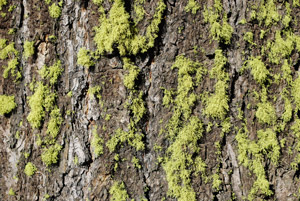
White Fir is a major component of forests from 4,000 to 6,500 feet and is a lesser component of the forest below 4,000 feet. Because it is unable to control water loss as efficiently as species such as ponderosa pine, it prefers the cooler and moister conditions at higher elevations. It is shade-tolerant and tends to grow in the forest understory in great numbers. Fire suppression and logging practices since 1900 have allowed White Fir to become a larger component of the mixed conifer forest than was historically the case. White Fir needles are 2 inches long and are attached separately to the branch. Unlike pine cones, White Fir cones stand upright on the branch. They are 3 to 5 inches long, gray-green in color, and, when mature, disintegrate on the tree. Rarely will you find whole cones on the ground unless a squirrel has cut one down. Juvenile trees have thin bark and many limbs with dense foliage. These characteristics make this species vulnerable to forest fires. Young trees in dense forests are almost always killed by fire. The tree produces good lumber and plywood. However, the soft wood decays readily if it is killed by fire, disease, or insects, making White Fir suitable for cavity-nesting birds and animals. After a fire, foresters estimate White Firs must be salvaged within one year to produce sound lumber.
More Information
Further information on tree species can be found in an excellent Forest Service publication: Silvics of North America.
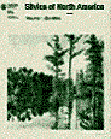
Credits: Information in the "Tree Species" section is derived from the "60 Second Forester," developed by the Northern California Society of American Foresters and the California Licensed Foresters Association.

